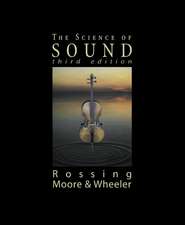Modelling Language Behaviour: Springer Series in Language and Communication, cartea 10
Autor R. Narasimhanen Limba Engleză Paperback – 7 dec 2011
Din seria Springer Series in Language and Communication
- 15%
 Preț: 637.59 lei
Preț: 637.59 lei - 15%
 Preț: 636.30 lei
Preț: 636.30 lei - 15%
 Preț: 643.84 lei
Preț: 643.84 lei -
 Preț: 386.22 lei
Preț: 386.22 lei - 15%
 Preț: 634.68 lei
Preț: 634.68 lei - 18%
 Preț: 724.80 lei
Preț: 724.80 lei -
 Preț: 377.73 lei
Preț: 377.73 lei -
 Preț: 388.72 lei
Preț: 388.72 lei -
 Preț: 385.62 lei
Preț: 385.62 lei -
 Preț: 379.48 lei
Preț: 379.48 lei -
 Preț: 387.58 lei
Preț: 387.58 lei - 15%
 Preț: 635.15 lei
Preț: 635.15 lei -
 Preț: 383.12 lei
Preț: 383.12 lei - 15%
 Preț: 632.37 lei
Preț: 632.37 lei -
 Preț: 384.31 lei
Preț: 384.31 lei - 15%
 Preț: 650.04 lei
Preț: 650.04 lei -
 Preț: 386.00 lei
Preț: 386.00 lei -
 Preț: 402.00 lei
Preț: 402.00 lei - 18%
 Preț: 729.53 lei
Preț: 729.53 lei -
 Preț: 387.20 lei
Preț: 387.20 lei - 5%
 Preț: 725.59 lei
Preț: 725.59 lei - 15%
 Preț: 635.15 lei
Preț: 635.15 lei - 15%
 Preț: 631.53 lei
Preț: 631.53 lei -
 Preț: 396.24 lei
Preț: 396.24 lei -
 Preț: 387.96 lei
Preț: 387.96 lei - 15%
 Preț: 640.24 lei
Preț: 640.24 lei -
 Preț: 378.54 lei
Preț: 378.54 lei
Preț: 637.59 lei
Preț vechi: 750.11 lei
-15% Nou
Puncte Express: 956
Preț estimativ în valută:
121.100€ • 127.72$ • 100.95£
121.100€ • 127.72$ • 100.95£
Carte tipărită la comandă
Livrare economică 07-21 aprilie
Preluare comenzi: 021 569.72.76
Specificații
ISBN-13: 9783642679360
ISBN-10: 3642679366
Pagini: 240
Ilustrații: XVI, 220 p.
Dimensiuni: 155 x 235 x 13 mm
Greutate: 0.34 kg
Ediția:Softcover reprint of the original 1st ed. 1981
Editura: Springer Berlin, Heidelberg
Colecția Springer
Seria Springer Series in Language and Communication
Locul publicării:Berlin, Heidelberg, Germany
ISBN-10: 3642679366
Pagini: 240
Ilustrații: XVI, 220 p.
Dimensiuni: 155 x 235 x 13 mm
Greutate: 0.34 kg
Ediția:Softcover reprint of the original 1st ed. 1981
Editura: Springer Berlin, Heidelberg
Colecția Springer
Seria Springer Series in Language and Communication
Locul publicării:Berlin, Heidelberg, Germany
Public țintă
ResearchCuprins
1 A Framework for Modelling Behaviour.- 1.1 Preliminary Remarks.- 1.2 The Nature of Scientific Activity.- 1.3 Explanations in the Physical and the Behavioural Sciences.- 1.4 The Need for a New Experimental Framework.- 2 The Mediating Role of Language Behaviour.- 2.1 Human and Animal Communication Systems.- 2.2 Organism as a Behavioural System.- 2.3 Language Behaviour as a Second-Signalling System.- 3 Teaching Language Behaviour to Chimpanzees.- 3.1 Principal Objectives of the Review.- 3.2 The Washoe Project.- 3.3 The Sarah Project.- 3.4 The Lana Project.- 3.5 General Comments on the Chimpanzee Language Learning Experiments.- 4 Language Behaviour Schemata and Tokens in English.- 4.1 Language and Behavioural Pragmatics.- 4.2 Schemata for Descriptions.- 4.3 Schemata for Commands.- 4.4 Schemata for Controls.- 4.5 Concluding Comments.- 5 Implications of the Model for Child Language Acquisition.- 5.1 Scope of the Chapter.- 5.2 The Language Acquisition Phenomena.- 5.3 Developmental Stages in Language Acquisition.- 5.4 The Language Acquisition Process.- 5.5 Linguistics and Language Behaviour.- 6 Computer Simulation of Language Behaviour.- 6.1 Relevance of Computer Simulation to Theory Construction.- 6.2 Interpretation Assignment in Grammar-Based Models.- 6.3 PLAS, a Paradigmatic Language Acquisition System.- 6.4 Modelling Conversational Language Behaviour.- 6.5 Concluding Remarks.- Appendix A Listing of Schemata in Helen’s Speech.- Appendix B Listing of Tokens in Helen’s Speech.- Appendix C PLAS: An Illustration of Its Performance.- References.- Author Index.
















